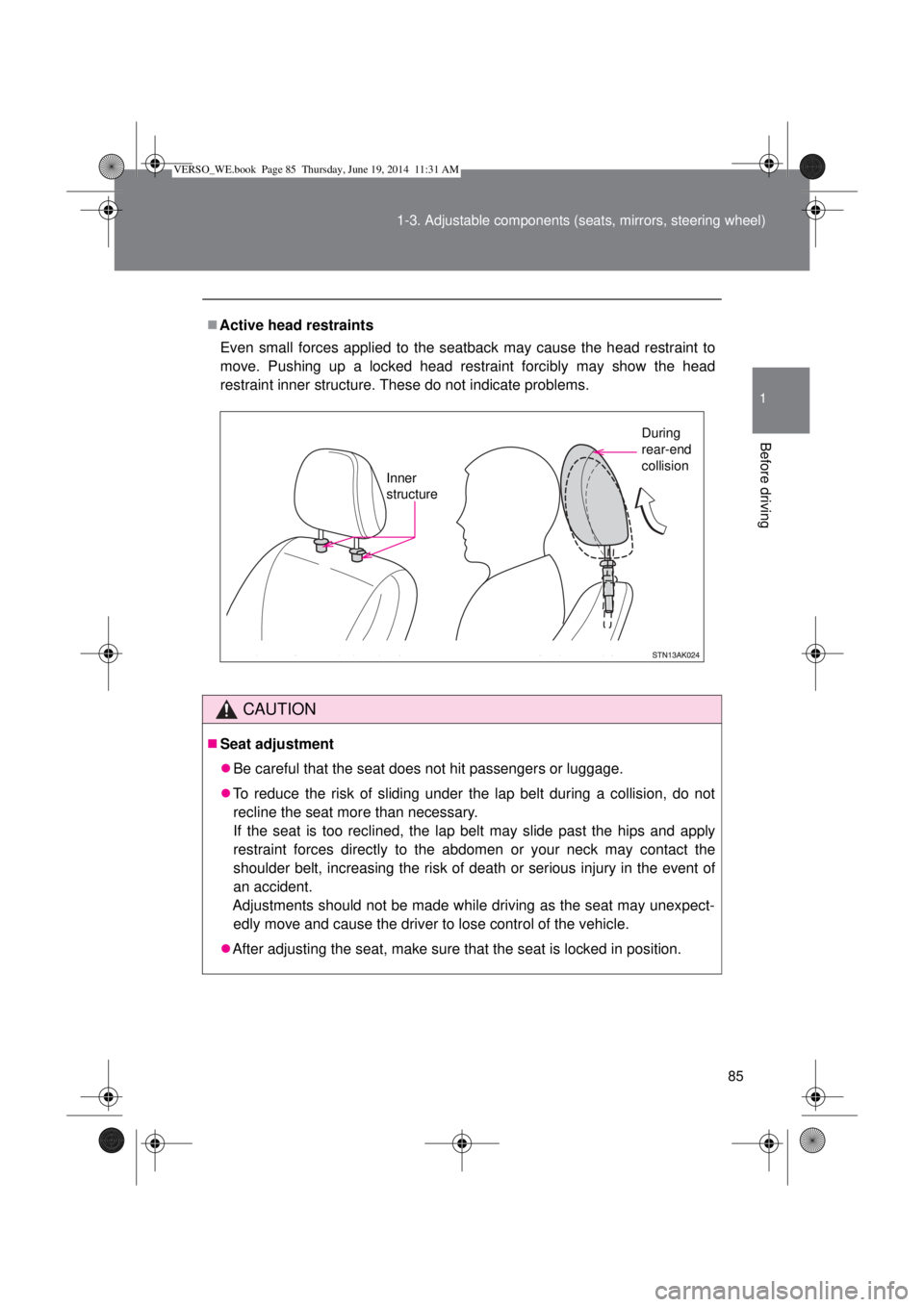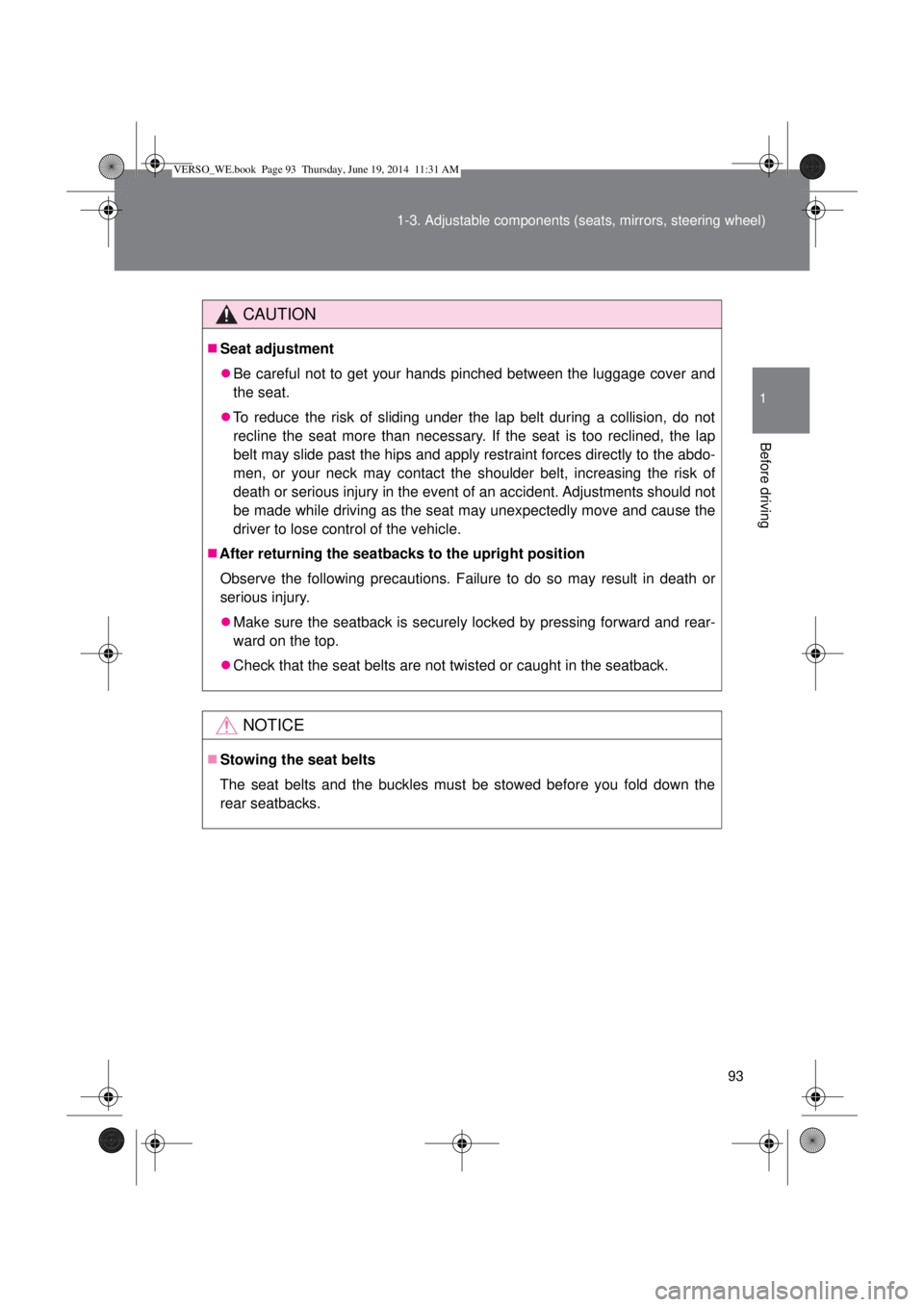Page 83 of 650
83 1-2. Opening, closing and locking the doors
1
Before driving
NOTICE
Back door damper stays
The back door is equipped with damper stays that hold the back door in
place.
Observe the following precautions.
Failure to do so may cause damage to the back door damper stay, resulting
in malfunction.
Do not attach any foreign objects, such
as stickers, plastic sheets, or adhesives
to the damper stay rod.
Do not touch the damper stay rod with
gloves or other fabric items.
Do not attach any accessories other
than genuine Toyota parts to the back
door.
Do not place your hand on the damper
stay or apply lateral forces to it.
Damper stay rod
VERSO_WE.book Page 83 Thursday, June 19, 2014 11:31 AM
Page 85 of 650

85 1-3. Adjustable components (seats, mirrors, steering wheel)
1
Before driving
Active head restraints
Even small forces applied to the seatback may cause the head restraint to
move. Pushing up a locked head restraint forcibly may show the head
restraint inner structure. These do not indicate problems.
CAUTION
Seat adjustment
Be careful that the seat does not hit passengers or luggage.
To reduce the risk of sliding under the lap belt during a collision, do not
recline the seat more than necessary.
If the seat is too reclined, the lap belt may slide past the hips and apply
restraint forces directly to the abdomen or your neck may contact the
shoulder belt, increasing the risk of death or serious injury in the event of
an accident.
Adjustments should not be made while driving as the seat may unexpect-
edly move and cause the driver to lose control of the vehicle.
After adjusting the seat, make sure that the seat is locked in position.
Inner
structure
During
rear-end
collision
VERSO_WE.book Page 85 Thursday, June 19, 2014 11:31 AM
Page 88 of 650
88 1-3. Adjustable components (seats, mirrors, steering wheel)
Pull up the walk-in lever and fold
down the seatback. The seat will
slide forward.
Move the seat to the front-most
position.
Getting out of the vehicle
Pass the outside seat belt
through the seat belt hanger.
This prevents the shoulder belt
from being damaged.
Pull up the walk-in lever and fold
down the seatback. The seat will
slide forward.
Move the seat to the front-most
position.
Make sure that no passenger is
seated on the second seat before
operating the walk-in lever.
After passengers have entered/exited the vehicle
Lift up the seatback and slide the seat backward until it locks.
Remove the outside seat belt from the seat belt hanger.
VERSO_WE.book Page 88 Thursday, June 19, 2014 11:31 AM
Page 90 of 650
90 1-3. Adjustable components (seats, mirrors, steering wheel)
Folding down the second seats
Pull up the seatback angle
adjustment lever and fold down
the seatback.
Returning the second seats
Lift up the seatbacks until they lock.
Remove the outside seat belts from the seat belt hangers.
Replace the second center seat belt. (P. 98)
Folding down the third seats (vehicles with third seats)
Before folding down the third seats
Stow the seat belt buckles as
shown.
VERSO_WE.book Page 90 Thursday, June 19, 2014 11:31 AM
Page 92 of 650
92 1-3. Adjustable components (seats, mirrors, steering wheel)
From outside
Open the back door and pull the
lock release strap to fold down
the third seats.
Returning the third seats
Lift up the seatbacks until they lock.
Remove the outside seat belts from the seat belt hangers.
CAUTION
When folding the rear seatbacks down
Observe the following precautions. Failure to do so may result in death or
serious injury.
Do not fold the seatbacks down while driving.
Stop the vehicle on level ground, set the parking brake and shift the shift
lever to “P” (Multidrive or automatic transmission) or “1” (manual transmis-
sion).
Do not allow anyone to sit on a folded seatback or in the luggage compart-
ment while driving.
Do not allow children to enter the luggage compartment.
VERSO_WE.book Page 92 Thursday, June 19, 2014 11:31 AM
Page 93 of 650

93 1-3. Adjustable components (seats, mirrors, steering wheel)
1
Before driving
CAUTION
Seat adjustment
Be careful not to get your hands pinched between the luggage cover and
the seat.
To reduce the risk of sliding under the lap belt during a collision, do not
recline the seat more than necessary. If the seat is too reclined, the lap
belt may slide past the hips and apply restraint forces directly to the abdo-
men, or your neck may contact the shoulder belt, increasing the risk of
death or serious injury in the event of an accident. Adjustments should not
be made while driving as the seat may unexpectedly move and cause the
driver to lose control of the vehicle.
After returning the seatbacks to the upright position
Observe the following precautions. Failure to do so may result in death or
serious injury.
Make sure the seatback is securely locked by pressing forward and rear-
ward on the top.
Check that the seat belts are not twisted or caught in the seatback.
NOTICE
Stowing the seat belts
The seat belts and the buckles must be stowed before you fold down the
rear seatbacks.
VERSO_WE.book Page 93 Thursday, June 19, 2014 11:31 AM
Page 94 of 650
94
1-3. Adjustable components (seats, mirrors, steering wheel)
Head restraints
Front seats
Vertical adjustment
Up
Pull the head restraints up.
Down
Push the head restraint down
while pushing the lock release
button.
Second seats (if equipped)
Vertical adjustment
Up
Pull the head restraints up.
Down
Push the head restraint down
while pushing the lock release
button.
Third seats (if equipped)
Vertical adjustment
Up
Pull the head restraints up.
Down
Push the head restraint down
while pushing the lock release
button.
Lock release
button
Lock
release
button
Lock release
button
VERSO_WE.book Page 94 Thursday, June 19, 2014 11:31 AM
Page 95 of 650
95 1-3. Adjustable components (seats, mirrors, steering wheel)
1
Before driving
Removing the head restraints
Adjusting the height of the head restraints
Adjusting the rear seat head restraint (vehicles with rear seats)
Always raise the head restraint one level from the stowed position when
using.
CAUTION
Head restraint precautions
Observe the following precautions regarding the head restraints. Failure to
do so may result in death or serious injury.
Use the head restraints designed for each respective seat.
Adjust the head restraints to the correct position at all times.
After adjusting the head restraints, push down on them and make sure
they are locked in position.
Do not drive with the head restraints removed.
Pull the head restraint up while pressing
the lock release button.
Make sure that the head restraints are
adjusted so that the center of the head
restraint is closest to the top of your ears.
VERSO_WE.book Page 95 Thursday, June 19, 2014 11:31 AM